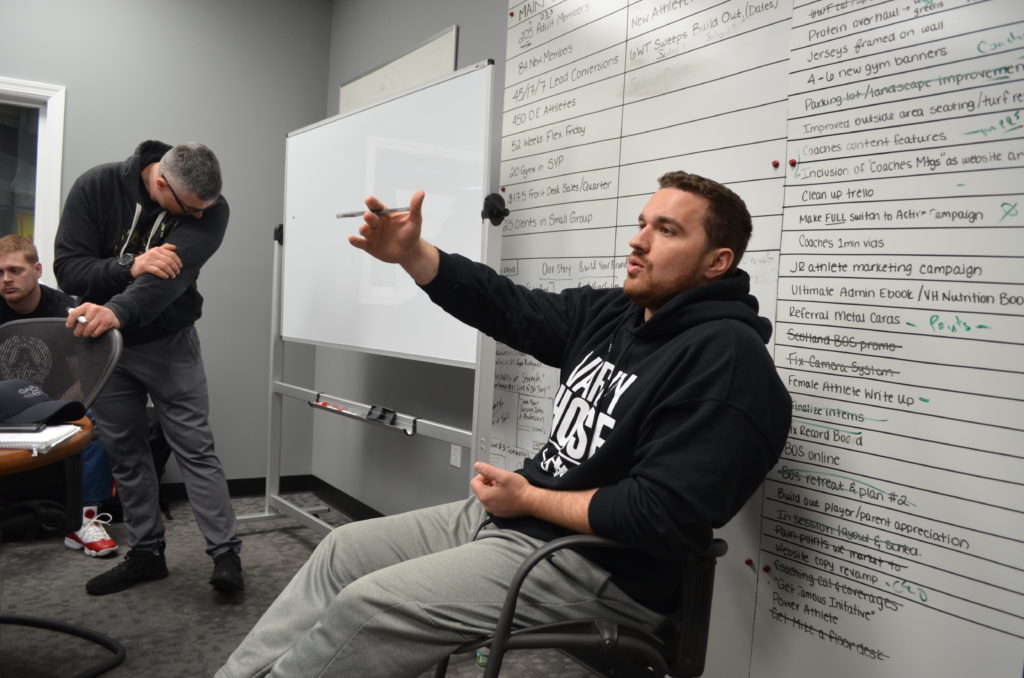1. Hold Meetings at Regular Intervals
There is tremendous power in routine. Establishing a pattern helps to build a habit for everyone in the group, which helps to create and maintain momentum.
More importantly, setting a recurring schedule signals a level of importance to everyone on the team — a forum is being established for regular, live, face-to-face communication.
Regular meetings also eliminate wasted time and energy in managing the logistics of adjusting meeting times.
2. Adjust the Level-10 Meeting Agenda and Format to Fit Each Meeting’s Specific Purpose.
There’s a danger in tip number one — routine can be powerful, but it can also deteriorate into dullness and complacency.
After establishing a pattern that signals importance and resolves logistical issues, it’s important to make great use of the time within each of the meetings.
As the challenges facing the team shift and as the dynamics of the environment change, reshape the content within the meeting accordingly.
Adjust your team meeting agenda strategically. Shift the format to accommodate the work at hand. If the goals of the meeting are best met by free form discussion, then lead a free form discussion. If a workshop exercise is most appropriate, run the workshop exercise. If decisions need to be made, make sure they get made.
Small changes can keep meetings fresh too. Something as simple as ending a meeting early when all the objectives have been met or bringing snacks or sharing a thank you note from a happy customer can help to mix things up in a small way and generate positive energy. Make some part of the meeting unpredictable and surprising from time to time to inject fresh energy into the meeting.
3. Make Sure Everybody Speaks Up and Contributes
Don’t let anyone sit idle for an entire meeting. Meetings are live discussions that benefit from each person’s contributions.
Encourage participation by adopting an open tone, being supportive, and directly soliciting input from individuals. Show that everyone on the team can contribute – and that everyone on the team is expected to contribute.
In most groups this must be actively managed. Some individuals will tend to dominate a discussion, and some will tend to remain quiet. As the leader, it’s crucial that you find ways to politely curb the over-contributors and ways to encourage the quiet participants to speak up.
It’s particularly important to stay on top of this as team meeting topics shift over time. The dynamics can shift dramatically as the topics change.
A well-balanced discussion is going to move team goals forward faster and more effectively.
4. Ensure That Each Meeting is Well-Prepared
Each meeting must be run with intent. To do that properly, preparation is key. Somebody needs to prepare the Level-10 Meeting agenda each week. It doesn’t necessarily have to be the meeting leader, but the meeting leader is always responsible to make sure that preparation happens.
Once you have set the agenda and decided on the most appropriate format for your next gathering, the content needs to be developed.
If you are going to run a discussion, what are the key questions that must be answered? If you are reviewing some aspect of the project, who is preparing the summary presentation and analysis and what format will it take? If you are generating ideas to help shape future plans, what should each attendee be expected to bring to the session?
A good plan will lead to a clear set of preparation requirements. Good preparation will lead to a good meeting.
5. Don’t Waste Time with Status Updates & Tangents
Mundane updates aren’t a terribly good use of meeting time. Successful staff meetings avoid this wherever possible.
Tangents can consume a meeting. Avoid them at all cost. Let the issue be heard and move on.
While it’s important to let everyone know what is going on, it’s better to find another outlet for this information whenever possible. Meeting preparation can include writing and reading updates so that everyone comes in ready to use the time together more productively.
Exceptions, outliers, or anomalies can be presented in the live meeting effectively. These unusual updates be a helpful way to review crucial lessons or provoke insightful discussion.
Live meeting time is best used for analysis, debate, and decision making. Keeping meetings operating in these areas will make for a more dynamic and productive discussion and will create much higher levels of team engagement.
6. Be A Vulnerable Leader
The leader of the meeting doesn’t know everything, can’t make great decisions on his or her own, and needs the perspectives and input of others to inform future direction.
Everybody knows this, including you, so let go of old management stereotypes and embrace the value of team input.
Asking “what do you think?” Saying “I don’t know,” “I’m not sure,” or “How should we approach this?” can be some of the best ways you can show real leadership.
To get the best results you want everyone to contribute ideas and insights. You need to show that this is welcome and expected. You need to show that you need help as a leader, that you need real thought and real contributions.
You’re not bringing the group together to tell them what to do, you’re bringing the group together for collective analysis and decision making. The last thing you want is people to approach the meeting by trying to guess what the “right” answer is that the leader wants.
It can be a challenge to get people to speak up in meetings in the first place. Being comfortable showing some vulnerability and need for help is a powerful way to encourage greater participation.
7. Be Honest and Direct with Your Own Contributions Don’t be afraid to say what you really think.
If the team leader sets this tone, it will become adopted by the group and real, meaningful input can be gained from everyone.
You have opinions and ideas like everyone else. You should share them and prepare to be contested or corrected just like everyone else. One way to lead effectively is to participate in the meeting in the manner you expect from everyone else.
If you want others to tell you what they really think, then you should be prepared to share in the same way.
Don’t go crazy and don’t dwell on the negative, but don’t be afraid to get into the too often unspoken stuff that matters. The stuff that can really inform what’s happened to date and what strategies will work going forward.
Work doesn’t happen in a vacuum. It happens in a messy, chaotic, political place we call the office. Don’t ignore that.
Build trust over time as the group bonds in a “safe haven” of sorts for discussing these more sensitive aspects of work. And make sure it is clear that free flowing opinions and political insights should be discussed only to improve productivity and results, not as a gossip session.
8. Move Things Forward.
Decide the issue, work the solution, delegate the work and move on. People get excited when they see thing actually getting done right in front of their faces.
The number one thing that motivates each of us at work is a sense of progress. Use team meetings to develop plans and make decisions. Each of those milestones becomes a concrete sign of progress and an important signal to everyone on the team.
Of course, it’s important that you consistently follow through on those actions. Once a plan is made, stick to it. Don’t constantly revisit and reverse decisions.
Even simple things like following the agenda that is set for the meeting conveys a sense of progress.
One great way to emphasize a sense of progress is to celebrate wins. Major milestones merit special acknowledgement or even a team lunch. Celebrate the small wins too. They are important and can make for a good opportunity for some light-hearted fun by over-celebrating small things or giving out silly prizes or making up goofy award names.
The important thing is to continually find ways to demonstrate that the team is making progress.
9. Have Fun
Make sure you keep it fresh. Order food occasionally. Cut a meeting short after reaching a mile stone and get everyone outside for some fun. We like to order an ice cream truck in the summer or do our meeting outside at the picnic table. This lets people know that while the work is important so are the people.



